OWC™ Mercury Elite Pro™ Dual mini
Assembly Manual
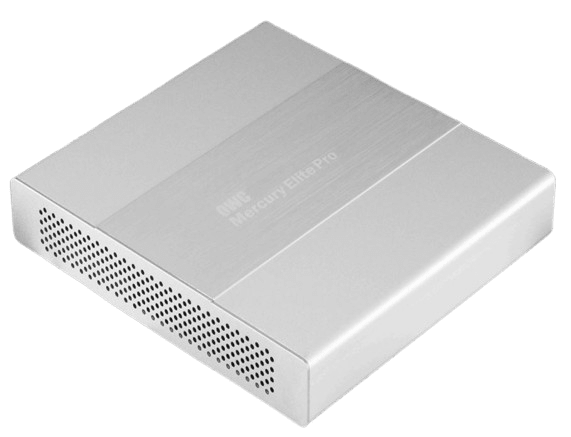
1 Introduction
1.1 System Requirements
1.1.1 Mac Requirements
- Minimum PowerPC® G4 CPU, 128MB RAM
- eSATA interface, Mac OS X 10.3 or later
- FireWire® interface, Mac OS X 10.2 or later
- USB 2.0 interface, Mac OS X 10.2 or later
1.1.2 PC Requirements
- Minimum 500MHz Intel® Pentium III CPU, 128MB RAM
- eSATA interface, Windows® XP / Vista® / Windows 7
- FireWire interface, Windows 2000 / XP / Vista / Windows 7
- USB 2.0 interface, Windows 2000 / XP / Vista / Windows 7
1.2 Package Contents
Item
- OWC Mercury Elite Pro Dual mini
- 18” Flexible eSATA cable
- 18” USB 2.0 (A-B) cable
- Software CD Bundle
- User Guide & Owner’s Manual
- Screws to attach hard drives
- 18” FireWire 800 to 12V Power cable
- 18” FireWire 800 (1394B) cable
1.3 About This Manual
Firmware, images, and descriptions may vary slightly between this manual and the unit shipped. Functions and features may change depending on the firmware version. Please visit the product webpage for the most recent specifications.
1.4 Port View & Cable Connections
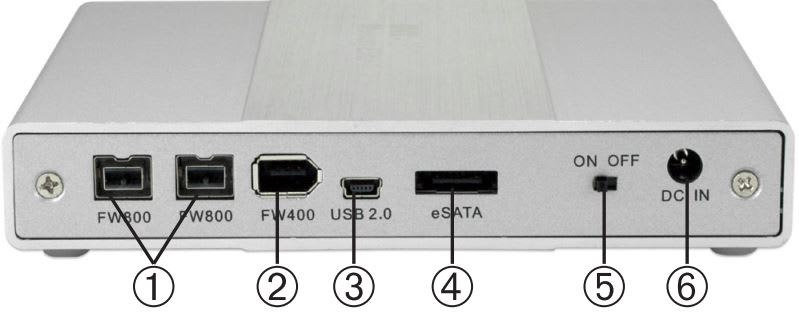
The OWC Mercury Elite Pro Dual mini comes equipped with multiple connection interfaces to ensure the maximum computer compatibility and portability.
FireWire
The Mercury Elite Pro Dual mini features two FireWire 800 ports 1 and one FireWire 400 port 2. FireWire 800 provides speeds up to 100 MB/sec and FireWire 400 provides speeds up to 50 MB/sec.
The use of FireWire does not require any auxiliary power source as each port carries enough bus power to run the Mercury Elite Pro Dual mini directly from the computer’s FireWire port.
FireWire also has the ability to daisy-chain or connect multiple FireWire devices together through one FireWire connection to the computer. OWC recommends having only one bus-powered device in the chain due to the limited amount of power a single FireWire port can provide. If a FireWire 400 device is chained with FireWire 800 devices, all devices will throttle down to FireWire 400 speeds.
USB
The Mercury Elite Pro Dual mini features one USB mini port 3 that provides speeds up to 60 MB/s.
The USB connection cannot carry enough power for the Mercury Elite Pro Dual mini, so the use of the optional AC power adapter is needed to connect to the DC In power port 6.
Please see Section 4.2: Tips for information on purchasing the optional AC power adapter.
eSATA
The fastest connection on the Mercury Elite Pro Dual mini is the eSATA connection (4), which provides speeds up to 300 MB/sec.
eSATA is not a powered connection and requires the use of an auxiliary power source such as the included FireWire 800 to 12V cable or the optional AC power adapter to connect to the DC In power port 6. While connected via eSATA, the Mercury Elite Pro Dual mini can also be powered by utilizing any of the FireWire 800/400 ports. In this scenario, the Mercury Elite Pro Dual mini senses both the eSATA and FireWire connections and utilizes the eSATA for data and the FireWire for power only.
Power Switch
It is recommended to always utilize the On/Off power switch 5 to ensure proper startup and shutdown of the Mercury Elite Pro Dual mini when connecting and disconnecting from the computer. OWC recommends attaching the data and power cables before switching the power on. When disconnecting, make sure to unmount and then turn off the Mercury Elite Pro Dual mini before disconnecting the data and power cables.
1.5 Front Activity Light View
The Mercury Elite Pro Dual mini features two multi-color LED indicator lights. The left light corresponds to the left drive, with the right light corresponding to the right drive. Each LED light will illuminate red or blue in color to indicate different activities.
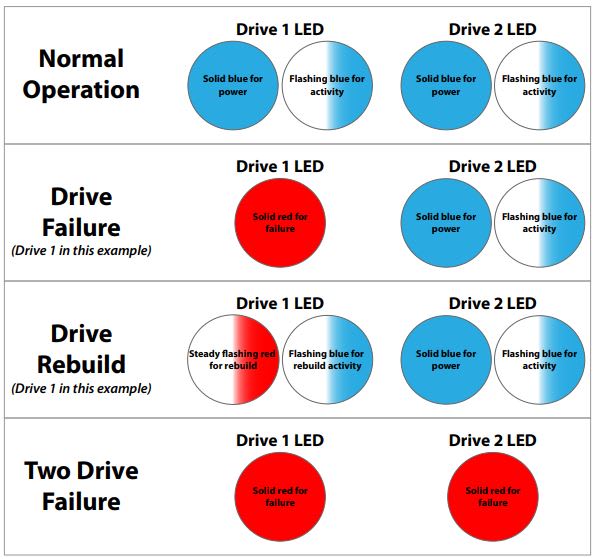
2 System Setup
Attention
Your computer is a static-sensitive device. It is susceptible to invisible damage if not protected during installation.
We recommend proper grounding by using a grounding strap. Make sure to work in a clean and static-free area, and avoid wearing clothing that retains static charges.
For more information, please visit http://www.macsales.com/static
Got tools? If you don’t have the tools necessary to complete this installation, Newer Technology has a fantastic toolkit with everything you need included to perform this installation, and most common computer hardware installations.
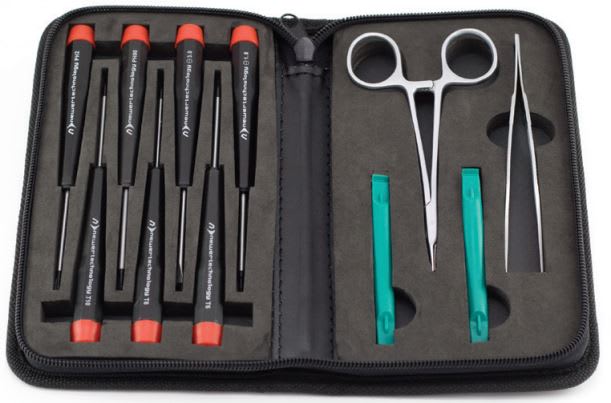
It’s available at: http://www.macsales.com/tools
2.1 Hard Drive Assembly & Installation
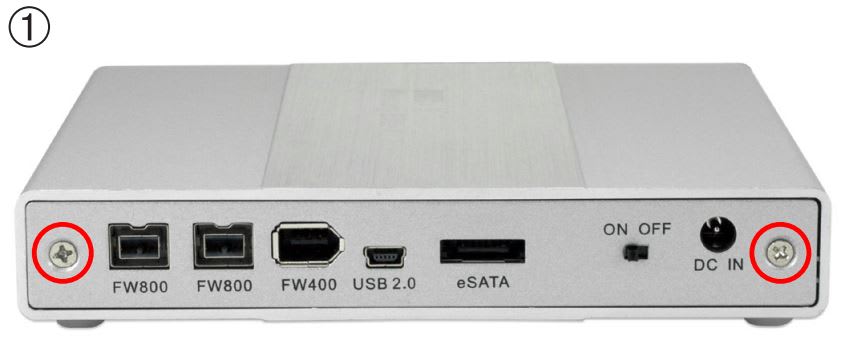
1. Using a Phillips P0 screwdriver, remove the 2 screws that hold the rear backplane cover to the enclosure.
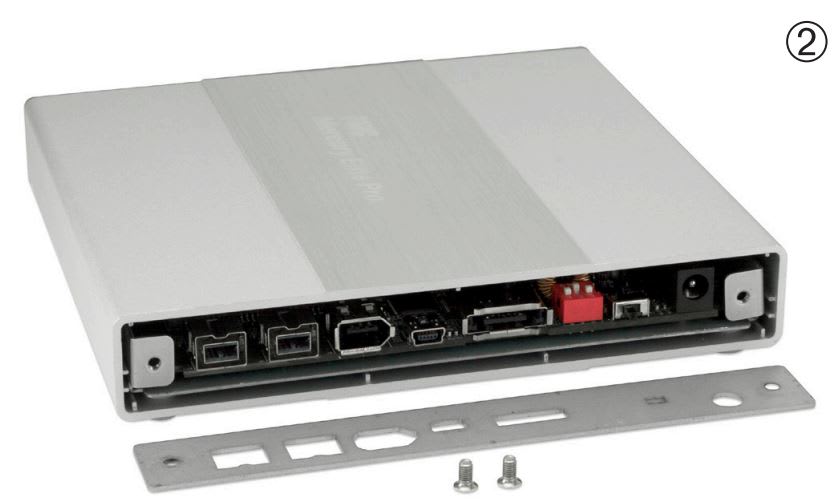
2. Once the screws are removed, the rear backplane cover will easily come off.
Set it aside to continue.
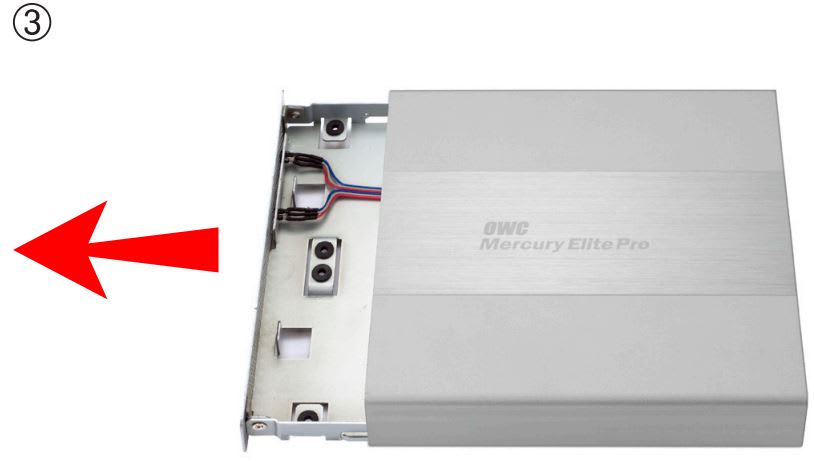
3. From the rear of the enclosure, press inwards on the rear ports to slide the inner chassis out towards the front of the enclosure.
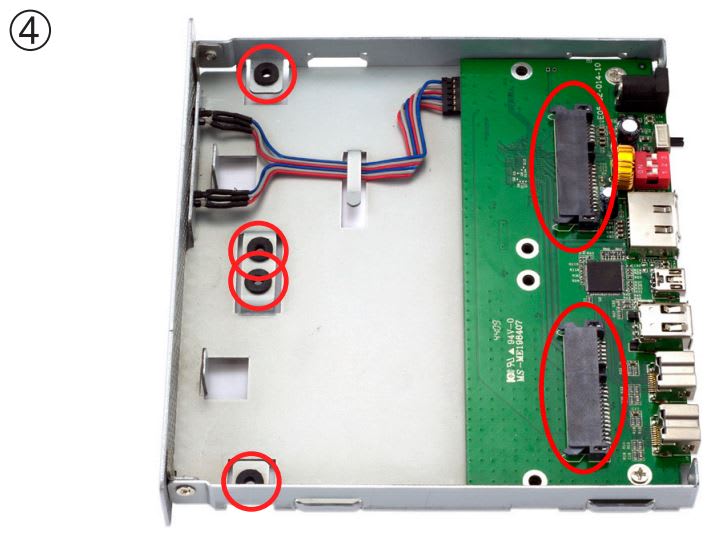
4. Once the inner chassis is removed from the outer shell, you will see where your 2.5” SATA drives will attach to the bridge card.
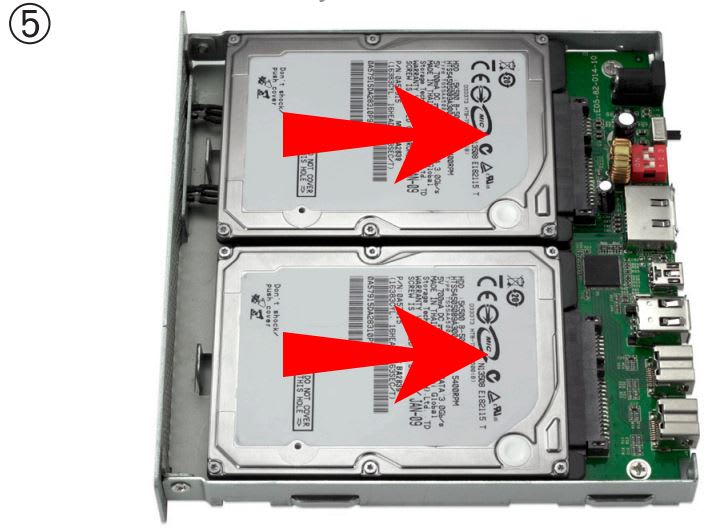
5. Place your drive mechanisms onto the bridge card, and press the drives towards the ports to firmly affix the drives into the SATA connectors.
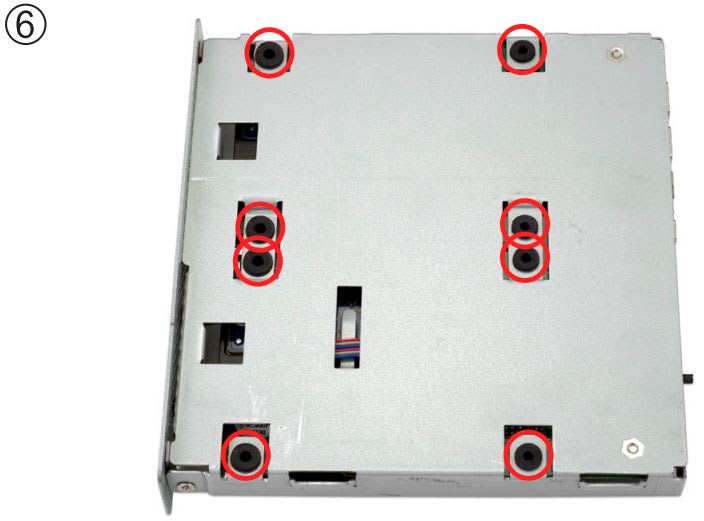
6. With your fingers holding the drive mechanisms into the enclosure, flip it over onto the top so you can see the screw holes that you will need to use in the next step.
7. Using the included screws from the plastic bag, attach the drive mechanisms to the enclosure through the rubber grommets using your Phillips P0 screwdriver.
It is recommended that you start using 2 screws in each drive, and not fully tighten them until all 8 screws are started into the drive mechanisms.
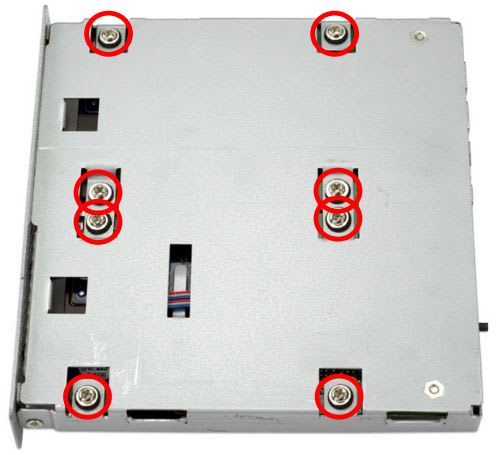
RAID Configuration Note:
Before proceeding further, look at the next page of this manual, Section 2.2 RAID Configuration and confirm that the enclosure is properly configured for the RAID type that you wish to use.
Failure to do this step before assembling the enclosure will result in you having to dissasemble the unit to configure the RAID.
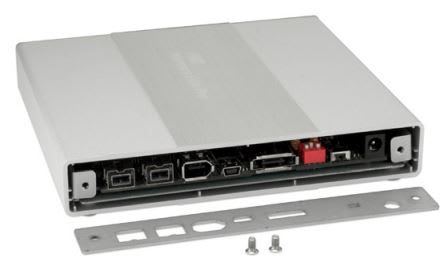
8. Once you have installed the drive mechanisms, simply slide the inner chassis back through the outer shell. The outer shell can be installed in either direction, but there is a notch on one side that allows the back plate to fit properly. If your case gets turned around and the back plate does not fit correctly, try reinstalling it from the other side.
9. Then, place the rear port cover onto the back of the enclosure, and attach it using the 2 Phillips screws and your Phillips P0 screwdriver you removed to begin the process.
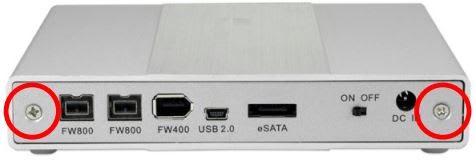
2.2 RAID Configuration
To adjust the RAID configuration on your OWC Mercury Elite Pro Dual mini, you need to gain access to the internal bridge board. Visit Section 2.1; Hard Drive Assembly & Installation to review the basic steps in this procedure.
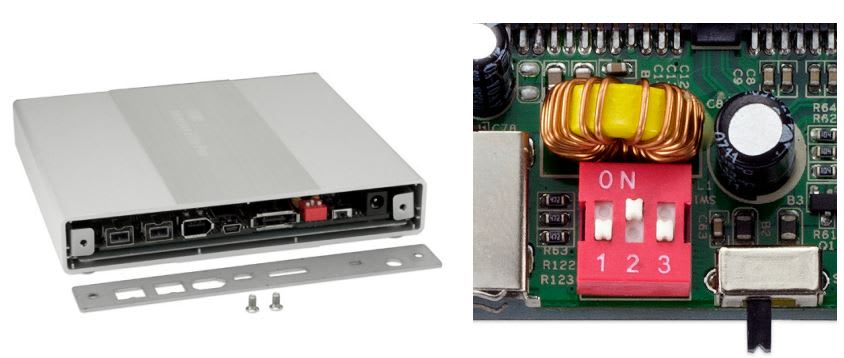
Once you remove the back of the OWC Mercury Elite Pro Dual mini, you will be able to see the blue DIP Switch block at the rear of the bridge card, next to the power switch. You need to adjust the DIP switches to change the RAID mode.
| MODE | SW#1 | SW#2 | SW#3 |
|---|---|---|---|
| SINGLE DRIVES | ON | OFF | OFF |
| RAID 0 STRIPE | ON | ON | OFF |
| RAID 1 | ON | ON | ON |
| SPAN | ON | OFF | ON |
Since hard drives have been introduced with capacities greater than 2.2TB, the industry has worked to resolve known capacity addressing limitations that date back to the original design of the PC.
These limitations are caused by 32-bit definitions used for partition sizes and logical block addresses (LBAs) resulting in a maximum addressable capacity size of 2.199TB.
The most direct way to resolve this issue is to use Long LBAs. However, Long LBAs are only supported in 64-bit operating systems, like Mac OS X, Windows 7 and Windows Vista. Users of older operating systems wishing to use these high-capacity drives will need to limit the drive size to under 2.2TB to be able to use the storage solution.
To limit the OWC Mercury Elite Pro Dual mini’s maximum drive capacity to 2.2TB, flip the dip switch #1 to the off position. The default position is up, or ON meaning volumes larger than 2.2TB are able to be created.
The OWC Mercury Elite Pro Dual mini is able to utilize the 2 hard drives in 3 different RAID modes; Disk Spanning (SPAN), Disk Striping (RAID-0), or Disk Mirroring (RAID-1). You need to choose the RAID mode that suits your needs properly.
The OWC Mercury Elite Pro Dual mini also is able to utilize drives in “Single Drive” mode. This is useful if you have two drives of different capacities or speeds and wish to install them in the enclosure, without the benefit of a RAID.
Disk Spanning

The drives show up as one large single volume. The total size will depend on the drives installed, you can use drives of different capacities. Spanning is an array (not RAID) that is written sequentially to, across the hard drives. By itself, it does not provide any performance or redundancy benefits.
Disk Striping (RAID 0)

The drives show up as one large (single) volume. It is highly recommended to use identical hard drives for this RAID method. However, you can utilize drives of different capacity, but realize that the RAID size will be based on the smallest capacity total of the drives used in the RAID set.
Disk Mirroring (RAID 1)

The drives show up as one volume, but only 50% of the total capacity can be used. It is highly recommended to use identical hard drives for this RAID method. However,while you can utilize drives of different capacity, the RAID size will be based on the smallest capacity total of the drives used in the RAID set. RAID 1 creates an exact copy (or “mirror”) of a set of data on the second drive. This is useful when reliability and backup are more important than capacity. When one drive fails, it can be replaced and the data rebuilt.
2.3 Computer Connections
Please see the previous Section 1.4 which details the different interface options available to you with your OWC Mercury Elite Pro Dual mini.
Choose which interface you wish to connect to your computer, connect that interface and then you need to format the hard drives you just installed into your new OWC Mercury Elite Pro Dual mini enclosure. Proceed to the next page to learn how to do that.
Important Note! You can connect multiple drives together using either of the FireWire connections. No other interface type supports this type of “daisy chain” connection. If you connect a FireWire 400 device, all devices connected via the FireWire bus, including FireWire 800 drives, will be reduced to the maximum speed of FireWire 400.
3 Formatting
3.1 Formatting your OWC Mercury Elite Pro Dual mini on a Macintosh with Mac OS X
IMPORTANT NOTE: This procedure will erase all data on your hard disk drives in the OWC Mercury Elite Pro Dual mini. Back up any important data before proceeding!
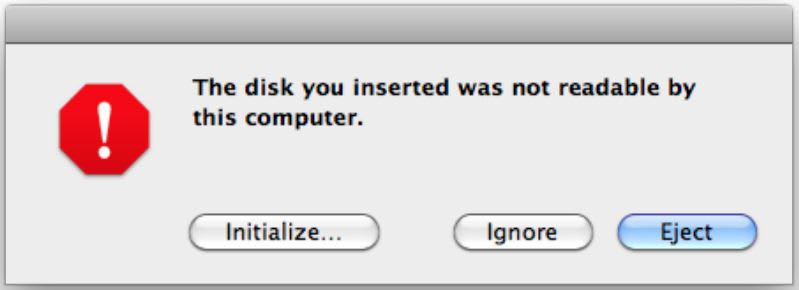
Click on the “Initialize” button. (If this does not appear, open Disk Utility located in /Applications/Utilities)
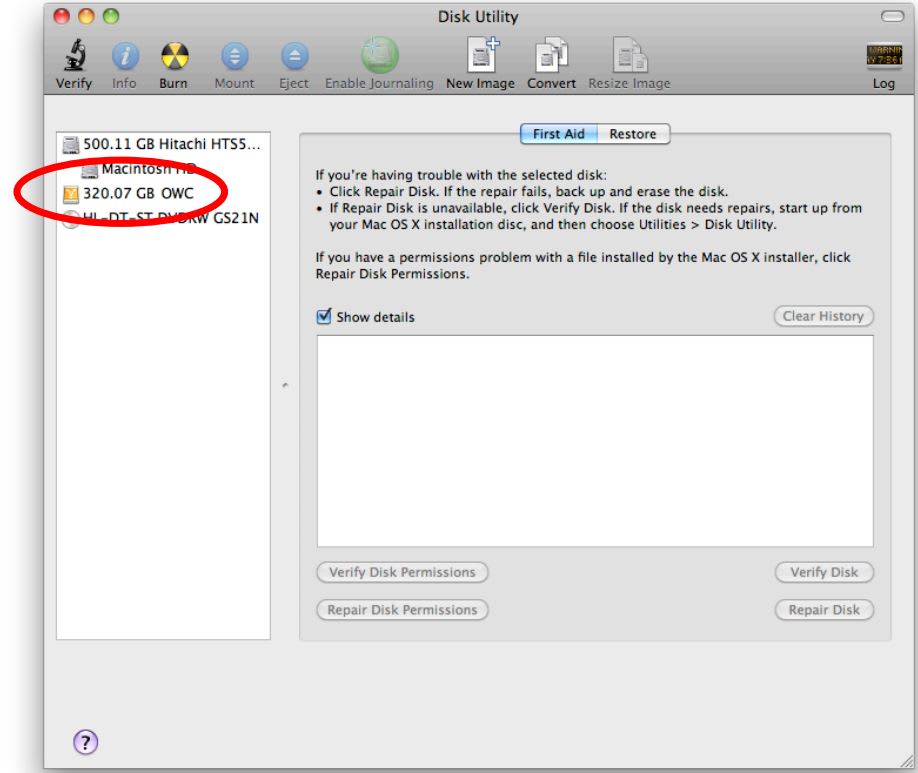
Select the device with no volumes attached to it; in this picture, that would be the 320.07 GB OWC device. Click on the picture of the drive icon next to the text.
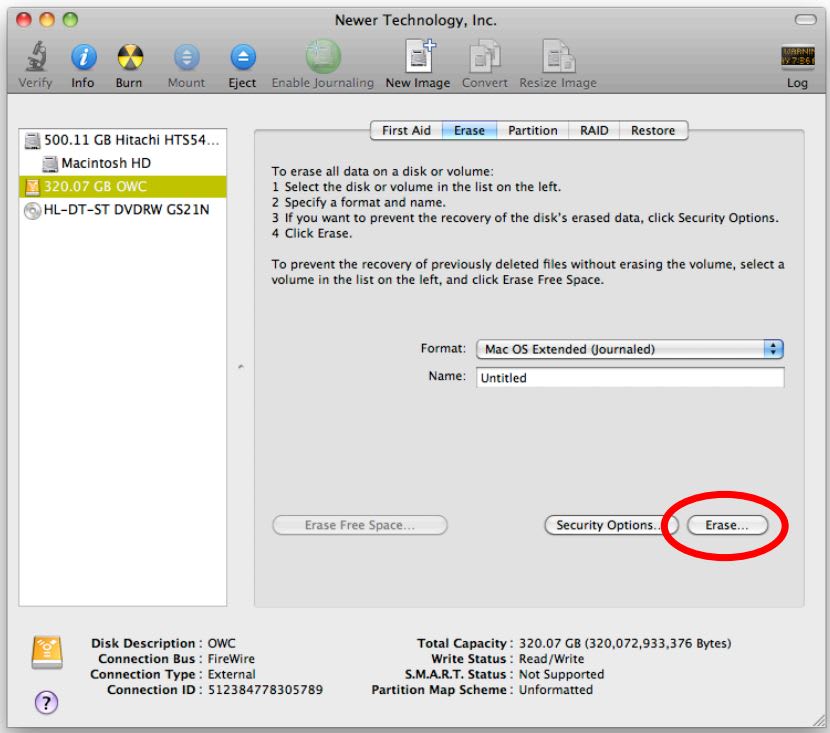
Once you’ve selected the OWC device, you will notice the above change in the Disk Utility application. Click on the “Erase” tab in this picture.
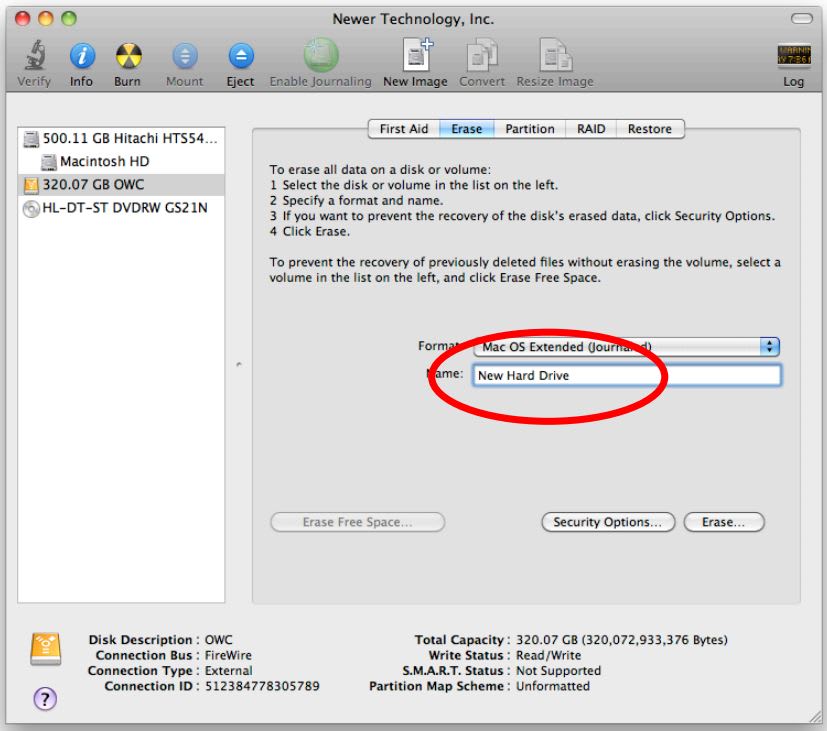
You then need to name the volume that you want to format, and erase it. Name the volume as you want, choose the Volume Format pulldown (Mac OS Extended (Journaled) is default), and click the Erase button.
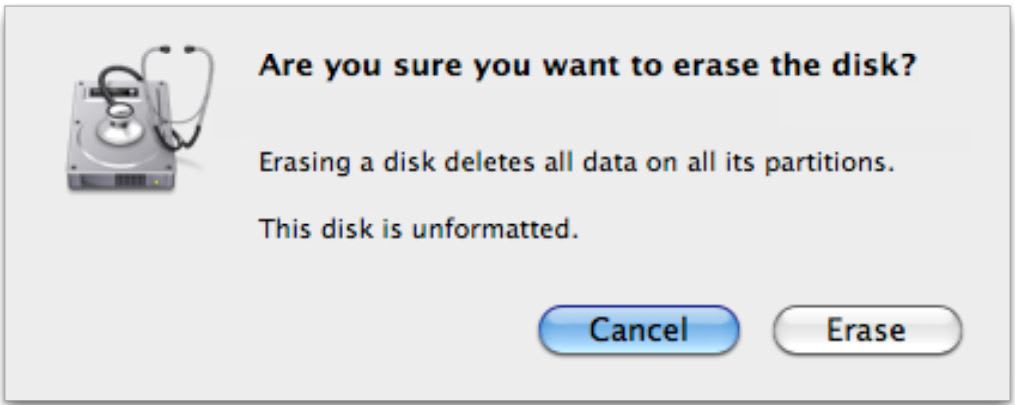
Click the erase button to confirm you wish to erase the disk.
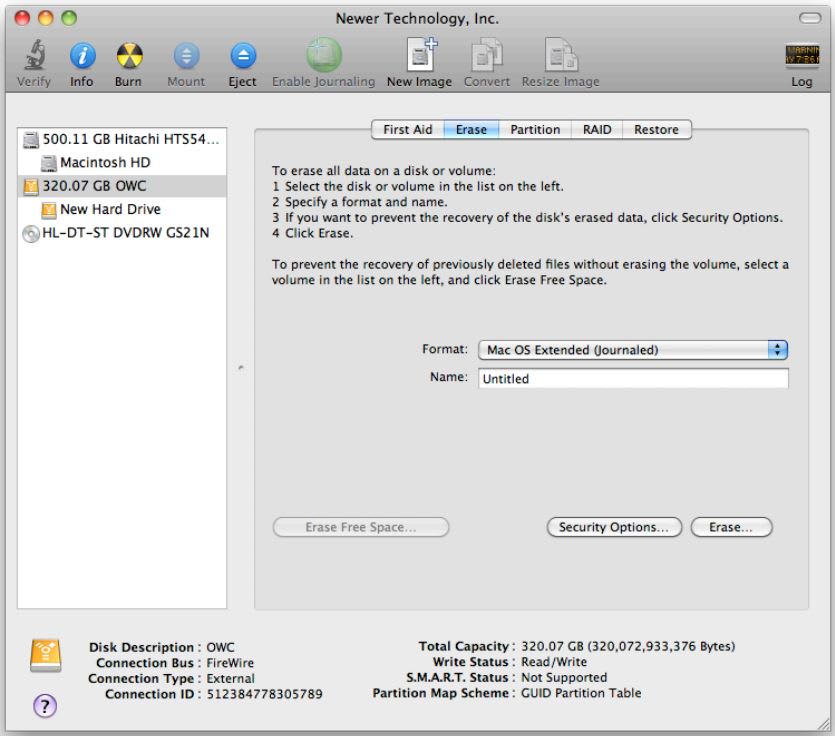
After a few moments, the erase command will complete and the OWC Mercury Elite Pro Dual mini volume will mount on your desktop. You can quit Disk Utility and start using your drive.
3.2 Removing the GUID Partition Scheme
Only for XP, 2000, ME and earlier. (XP 64-BIT, Vista & Windows 7 can continue to the next section)
If you are not installing a brand-new hard drive into your enclosure, it may have a GUID drive partition already installed on it, especially if it was originally used with a Macintosh. Unfortunately, this is not readable by Windows without special software. If you wish to use your storage solution on a computer running Windows, you will need to repartition and reformat using the following instructions.
1. Go to the DOS command prompt by selecting “Run” from the Start Menu.
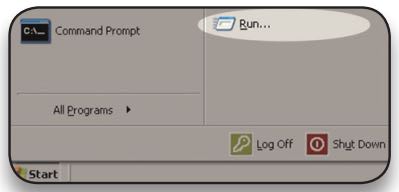
2. Type in cmd in text box, and hit the“OK” button.
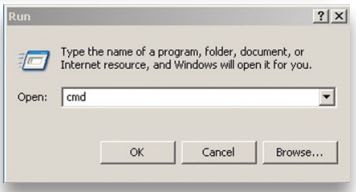
3. Type diskpart and hit enter.

4. Type list disk and hit enter.

5. Type select disk x replacing x with the number of the disk you want to reformat. (Typically, you will see an asterisk (*) under “GPT” for the disk requiring formatting.)

Warning
The clean command will destroy ALL data on the disk you run it on!!!
Be sure there is nothing you need to keep on your drive before running any of these commands.
6. Type clean and hit enter

7. Type exit and hit enter.
8. Close the command prompt window.
You may now proceed with formatting the drive.
3.3 Formatting your OWC Mercury Elite Pro Dual mini on Windows 2000 and later
Instructions for other operating systems can be found at http://www.macsales.com/format.
IMPORTANT NOTE: This procedure will erase all data on your hard disk drives in the OWC Mercury Elite Pro Dual mini. Back up any important data before proceeding!
1. With the drive connected to the computer and powered on, right click on the “My Computer” icon and select “Manage” from the menu. The “Initialize and Convert Disk Wizard” window should appear.
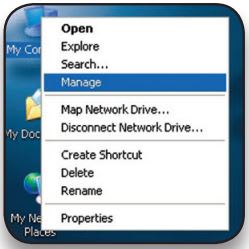
If the Wizard does not appear, expand the Storage menu by clicking on the plus (+) sign. Then, right click next to the disk number of the drive that you have just connected and click Initialize to bring up the Wizard.
2. In the next window, there should be only one drive listed. That will be the drive that you connected via eSATA, FireWire or USB. Make sure the box next to the drive name is checked and click “Next.”
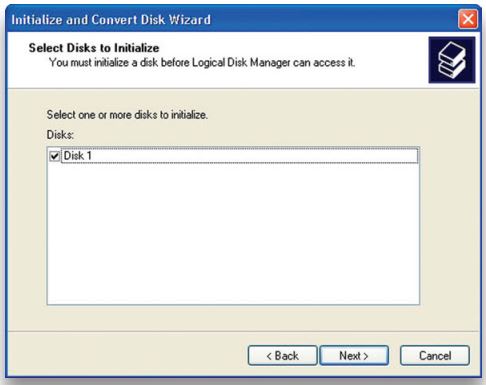
3. The Wizard will perform its tasks, and you will get the following screen. You may click “Finish.”
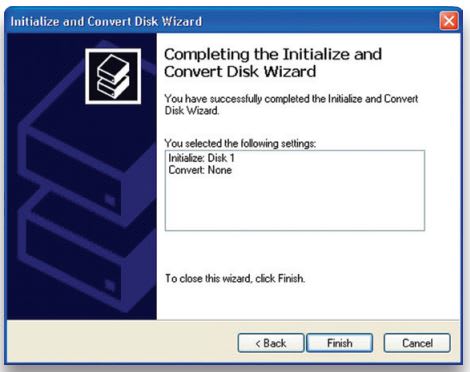
4. Your drive will appear similar to how Disk 1 does below. Notice that the space on the lower right reads as “Unallocated.” Right click in this space and choose “New Partition.”
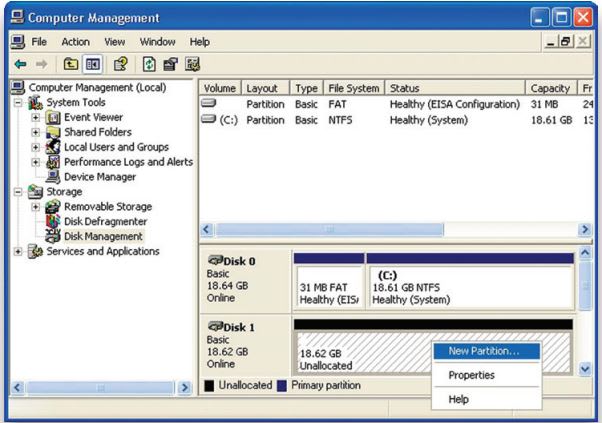
5. The “New Partition Wizard” will launch. Click “Next” to continue.
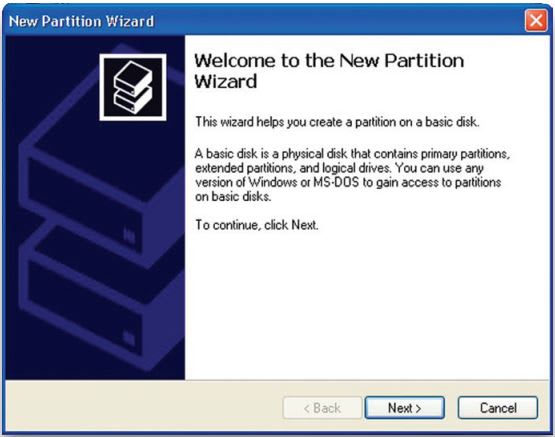
6. Specify your partition type as “Primary,” and click “Next.”
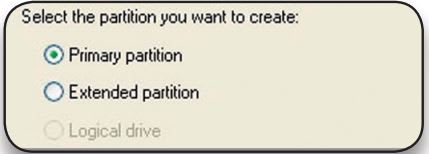
7. The wizard will display the maximum partition size for your drive. It is strongly recommended that you do not change the default value. Click “Next”
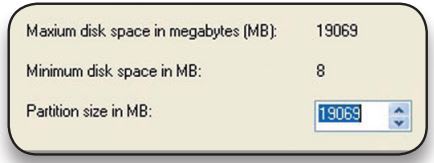
8. If you like, you can specify the drive letter designation for your new drive. Otherwise, one will automatically be assigned. Click “Next.”
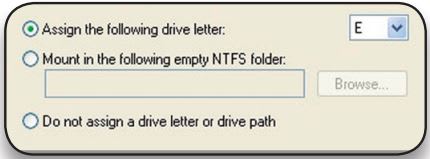
9. Before you can use the drive, it must be formatted. On most systems running Windows 2000 or later, it is advisable to specify the file system as NTFS. Leave the Allocation unit size as “Default,” and feel free to give the drive whatever name you prefer. Be sure to check the box “Perform a quick format”.
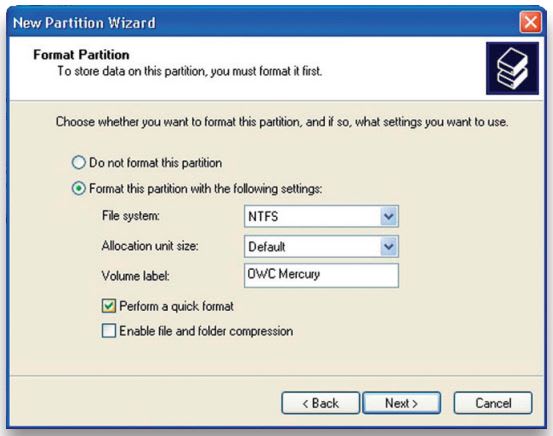
If you do not check the “Perform a quick format” box, it will take several hours for your drive to format. Click “Next.
10. At the end of the Wizard, you will see a summary of the information that you specified during the previous steps. Click “Finish.”
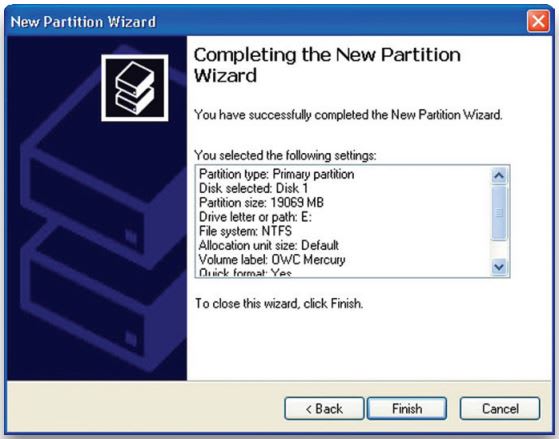
11. Once you have finished with the formatting wizard, you will see that your new drive (represented as “Disk E” in this case) will display a message of “Formatting.” This should only take a couple of minutes if you chose the quick format option.
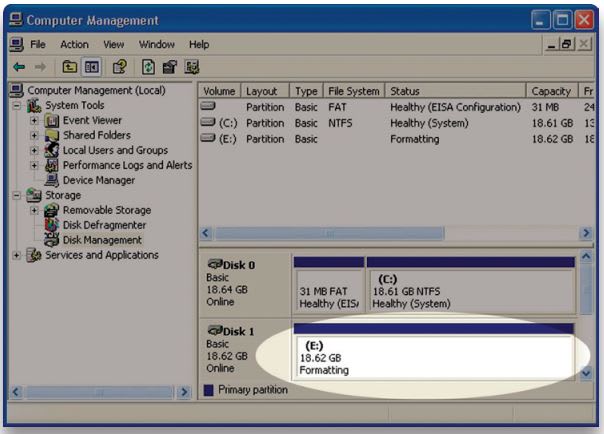
12. After a moment or two, the drive’s status will change from “Formatting” to “Healthy.”
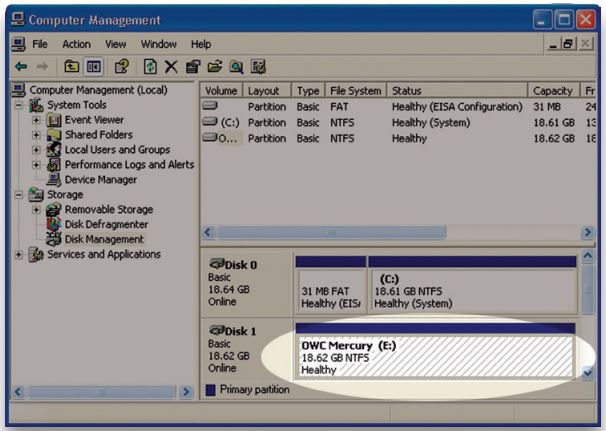
13. At this point, you may close the Computer Management window. Your drive is ready to use and can be found in “My Computer.”
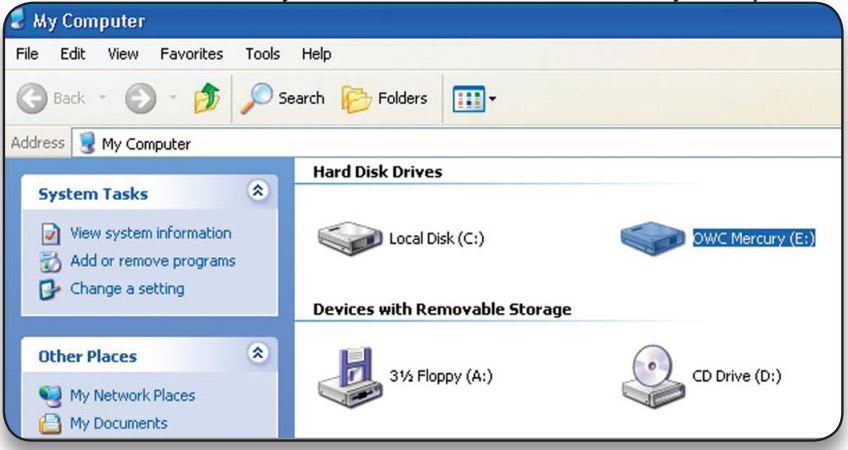
Using your new Storage Solution on both Macs and PCs?
MacDrive™ takes the guesswork out of sharing files. Whether you are transferring files between home and the office, a class room lab and your dorm room or even on the same computer, MacDrive makes it painless. In fact, you’ll hardly know MacDrive is working.
Once installed MacDrive will automatically give you access to any Mac disk you pop into your computer. MacDrive even puts an “apple” icon on the Mac disk, just to keep things clear.
You can access files on the Mac disk just like you would with a Windows formatted disk. Open files from the disk or from within a program. Mac files automatically get the right icons and file name extensions under both Windows and Mac OS.
Works great with software from Microsoft, Adobe, Quark, FileMaker, Avid, Digidesign, Corel, NewTek and more.
You can find MacDrive at: http://eshop.macsales.com/search/macdrive
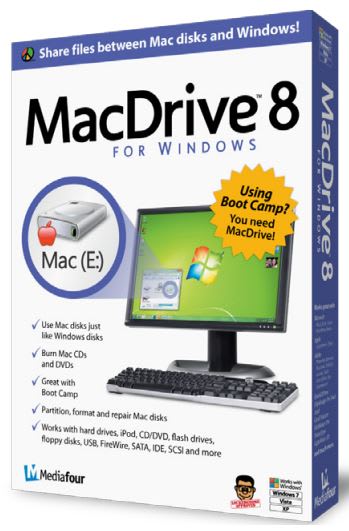
4 Troubleshooting, Tips & FAQ
4.1 Troubleshooting
Some of the most simple problems can be traced to power, or connectivity issues. Verify that your cables (both ends!) are properly plugged into the computer and storage solution. If one connection type does not work, switch to another interface and try the solution again. If these suggestions do not work, try the OWC Mercury Elite Pro Dual mini on a different computer, if available to you.
• Drive activity light changes color to RED:
One of the internal hard drives is not responding properly and the LED status lights are alerting you to this issue. You could have a failed hard drive; note that the OWC Mercury Elite Pro Dual mini’s LED lights correspond to the drive mechanism, left and right. You should be able to tell which drive mechanism is at fault and remove it from the enclosure for further testing or replacement.
If your OWC Mercury Elite Pro Dual mini is configured as a RAID-1 Mirror, you can install another identical capacity hard drive in place of the failed mechanism and the RAID will automatically rebuild, even if not connected to a computer. It’s suggested if you do have a failed drive and are using the OWC Mercury Elite Pro Dual mini in the RAID-1 configuration, that you let the unit sit overnight to completely finish the rebuilding process but you can continue to use the OWC Mercury Elite Pro Dual mini during the rebuild process as well.
• Drive activity light flashes between RED and BLUE (RAID-1 Mirror only):
One of the internal hard drives has been replaced, and the OWC Mercury Elite Pro Dual mini is rebuilding the RAID.
• Drive does not power up over eSATA connection:
The OWC Mercury Elite Pro Dual mini eSATA interface requires the use of a secondary uplink or auxiliary power adapter to use the eSATA interface. eSATA does not supply bus power. Please see section 4.2 for more information about those options.
• Drive connected via eSATA, but mounts as FireWire 800 device:
You are likely using a FireWire 800 cable to bus power the OWC Mercury Elite Pro Dual mini. Switch to using the FireWire 800 to 12V adapter cable or reboot with the drive turned on and both cables plugged in.
4.2 Tips
Identifying the LED indicators on your drive
The OWC Mercury Elite Pro Dual mini has 2 separate multicolor LED indicator lights that will illuminate different colors depending on the operation currently running.
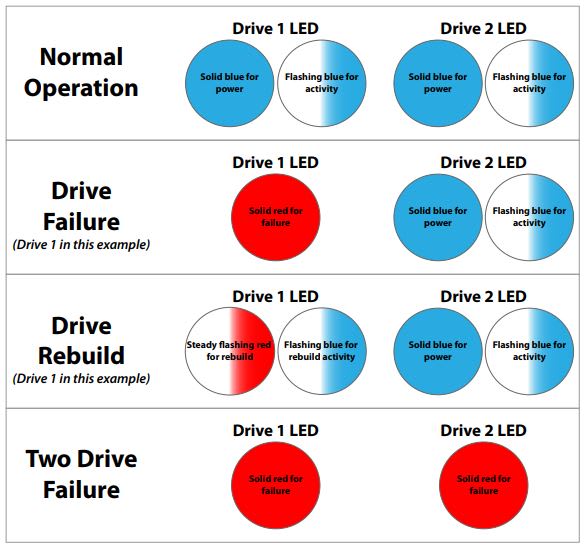
To properly unmount any connected hard drives from your computer, you need to follow a few simple steps.
• For Macintosh systems:
There are multiple methods to umount disks with Macintosh systems. Either drag the icon for the hard disk you wish to dismount to the trash can, or you can click the eject icon next to the hard disk name in under the “DEVICES” tab in the sidebar in any finder window, and finally another method is to right click on the hard drive icon on your desktop and select “Eject”.
• For Windows systems:
- Go to the System Tray (located in the lower right corner of your screen). Click on the Eject icon (a small green arrow over a hardware image).
- A message will appear, detailing the devices that the Eject icon controls. i.e. “Safely remove...” Click on this prompt.
- You will then be given the following message. “Safe to Remove Hardware”. It is now safe to unhook the OWC Mercury Elite Pro Dual mini.
Optional AC Adapter or FireWire 800 Power required for eSATA interface
While The OWC Mercury Elite Pro Dual mini series is designed to be bus powered via FireWire, connections using the eSATA interface do require a power source. There are two options available to do this; either using the included FireWire 800 power adapter cable, or using an AC power adapter. Simply connect one of these cables to the 12V port on the back of the OWC Mercury Elite Pro Dual mini.
If you want to purchase an AC adapter it is available from our Web site: http://eshop.macsales.com/item/Other%20World%20Computing/OWCELITE3AUS/
Optional AC Adapter required for USB interface
As with eSATA, connections via the USB interface do require a power source. If you want to purchase an AC adapter it is available from our Web site: http://eshop.macsales.com/item/Other%20World%20Computing/OWCELITE3AUS/
Backup Software
For Mac OS X, we have included Prosoft Engineering’s Data Backup™. Data Backup makes it easy to backup to FireWire and USB drives, network drives, CDs and even DVDs. Make schedules so you don’t need to ‘think’ about backing up… It does it for you. Your drive is also fully compatible with Apple’s Time Machine if you are running Mac OS X 10.5 “Leopard”.
For PCs running Windows 2000 and later, we have included Novastor’s NovaBACKUP™. Built-in support for hundreds of the most popular storage devices and a step-by-step backup and restore wizard makes NovaBACKUP extremely easy to use.
To install and use the included backup software for either OS, please insert the included CD and follow the installation and operation instructions on the disc.
Cloning your hard drive (making an exact copy of it):
If you want to make an exact duplicate of a hard drive, we highly recommend Mike Bombich’s donationware “Carbon Copy Cloner™”. It’s a great tool and is included with the bundled software CD provided with this storage solution.
Custom OS X Icons
If you wish to replace the custom OS X icon for your new hard drive, you can find instructions and a download link on our Web site: http://eshop.macsales.com/hdicons
5 Appendix
5.1 FAQ
Q: How do I format my storage solution?
A: OWC has detailed instructions online for most popular operating systems, located at: http://eshop.macsales.com/tech_center/fwhdd.cfm
Q: What file system should I choose when formatting my drive?
A: This will depend on how you want to use the drive, but in general we recommend:
- Mac OS X : HFS + (Mac OS Extended)
- Windows 2000/XP/Vista/7 : NTFS
- For cross-platform compatibility, FAT32 will work, but single file sizes are limited to 4GB. Other options using 3rd party software exist but are not covered here.
Q: Will the hard drives spin down when my computer goes to sleep or into stand-by mode?
A: Yes, they will spin down to save energy. It will take about 30 seconds to access your data after being in sleep or stand-by mode.
Q: One of my drives failed and I replaced it. Do I need to connect it to the computer to rebuild the data?
A: No, the rebuild will occur without being connected to the computer as long as the power is turned on to the enclosure.
Q: Can I install drives of different sizes in the enclosure?
A: Yes! See section 2.2 and adjust your RAID switches for “Single Drive” mode.
5.2 About Data Protection
To ensure that your files are protected and to prevent the loss of your data, we strongly suggest that you keep two copies of your data: one copy on your OWC Mercury Elite Pro Dual mini, and a second copy on either your internal hard drive or another storage medium, such as an optical backup, or on a second external hard drive. Any data loss or corruption while using the OWC Mercury Elite Pro Dualmini is the sole responsibility of the user, and under no circumstances will Other World Computing be held liable for compensation or the recovery of any lost data.
6 Customer Service
6.1 Before Contacting Customer Service
- Read this manual and review Chapter 4: Troubleshooting & Tips.
- Try to confirm the problem is with the hard drive. If you have a second computer, move the enclosure to that system and verify that the solution does not function with that machine.
Visit our tech center for more support suggestions, including FAQs. http://eshop.macsales.com/tech_center/index.cfm
If you still need support, please have the following available to you:
- The serial number of the enclosure
- Your invoice number
- What operating system you are using
- Which kind and model of computer you are using
All of this will help speed your support contact along.
Copyrights:
Copyright © 2010-2012 Other World Computing, Inc. All rights reserved. OWC is a registered trademark of Other World Computing. Other World Computing and Mercury Elite Pro are trademarks of Other World Computing. Other marks may be the trademark or registered trademark property of their respective owners.
No part of this publication may be reproduced, stored in a retrieval system, or transmitted in any form or by any means, electronic, mechanical, photocopying, recording or otherwise, without the prior written consent of Other World Computing.
Changes:
The material in this document is for information only and subject to change without notice. While reasonable efforts have been made in the preparation of this document to assure its accuracy, Other World Computing assumes no liability resulting from errors or omissions in this document, or from the use of the information contained herein. Other World Computing reserves the right to make changes or revisions in the product design or the product manual without reservation and without obligation to notify any person of such revisions and changes.
FCC Statement:
Warning! Modifications not authorized by the manufacturer may void the user’s authority to operate this device.
NOTE: This equipment has been tested and found to comply with the limits for a Class A digital device, pursuant to Part 15 of the FCC Rules. These limits are designed to provide reasonable protection against harmful interference when the equipment is operated in a commercial environment. This equipment generates, uses, and can radiate radio frequency energy and, if not installed and used in accordance with the instruction manual, may cause harmful interference with radio communications. Operation of this equipment in a residential area is likely to cause harmful interference, in which case the user will be required to correct the interference at his own expense.
NOTE: This equipment has been tested and found to comply with the limits for a Class B digital device, pursuant to Part 15 of the FCC Rules. These limits are designed to provide reasonable protection against harmful interference in a residential installation. This equipment generates, uses and can radiate radio frequency energy and, if not installed and used in accordance with the instructions, may cause harmful interference to radio communications. However, there is no guarantee that interference will not occur in a particular installation. If this equipment does cause harmful interference with radio or television reception, which can be determined by turning the equipment off and on, the user is encouraged to try to correct the interference by one or more of the following measures:
- Reorient or relocate the receiving antenna.
- Increase the separation between the equipment and receiver.
- Connect the equipment to an outlet on a circuit different from that to which the receiver is connected.
Health And Safety Precautions:
- Use proper anti-static precautions while performing the installation of your hard drives into this drive enclosure. Failure to do so can cause damage to your drive mechanisms, and / or the hard drive enclosure.
- Read this User’s Guide carefully, and follow the correct procedure when setting up the device.
- Do not open your hard drive or attempt to disassemble or modify it. Never insert any metallic object into the drive to avoid any risk of electrical shock, fire, short-circuiting or dangerous emissions. Your hard drive contains no user-serviceable parts. If it appears to be malfunctioning, have it inspected by a qualified Other World Computing Technical Support representative.
- Never expose your device to rain, or use it near water, or in damp or wet conditions. Never place objects containing liquids on the drive, as they may spill into its openings. Doing so increases the risk of electrical shock, short-circuiting, fire or personal injury.
General Use Precautions:
- Do not expose the enclosure to temperatures outside the range of 5° C to 40° C (41° F to 104° F). Doing so may damage the drive or disfigure its casing. Avoid placing your drive near a source of heat or exposing it to sunlight (even through a window). Conversely, placing your drive in an environment that is too cold or humid may damage the unit.
- Always unplug the hard drive from the electrical outlet if there is a risk of lightning or if it will be unused for an extended period of time. Otherwise, there is an increased risk of electrical shock, short-circuiting or fire.
- Use only the power supply shipped with the device.
- Do not use the hard drive near other electrical appliances such as televisions, radios or speakers. Doing so may cause interference which will adversely affect the operation of the other products.
- Do not place the drive near sources of magnetic interference, such as computer displays, televisions or speakers. Magnetic interference can affect the operation and stability of your hard drive.
- Do not place heavy objects on top of the drive.
- If you detect a problem, consult the Troubleshooting section in this manual.
- Protect your hard drive from excessive exposure to dust during use or storage. Dust can build up inside the device, increasing the risk of damage or malfunction.
- Other World Computing recommends the use of normal glass cleaning products to keep the high lustre finish at its finest with this product. Be sure not to get any moisture inside the holes and if you do, allow time to air dry before use.
- Do not block the ventilation outlets on the front of the drive. These help to keep your drive cool during operation. Blocking the ventilation outlets may cause damage to your drive and cause an increased risk of short-circuiting or fire.
Free Support Chat
Our free award-winning support team is ready to answer all of your questions. Technical support is available Monday - Friday: 9AM - 6PM. Customer Support & Sales is available Monday - Friday: 8AM - 8PM. Support is unavailable on U.S. Federal holidays. Talk to a human today.

 1-800-275-4576
1-800-275-4576